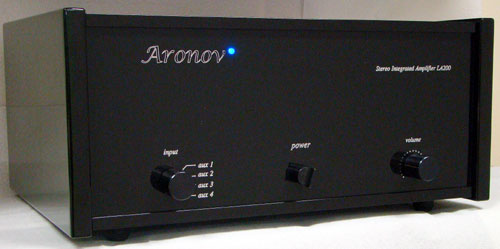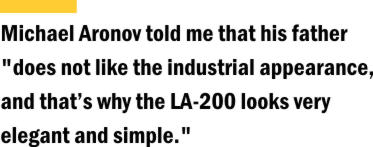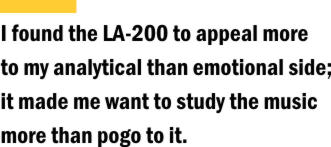Aronov Audio • LA-200 Integrated Amplifier
always try to avoid the temptation to upgrade. I fear that down that road lies madness -- and lots of money spent. The best way I've found to avoid the constant desire to give in to things that are forever becoming bigger, faster and stronger is to buy something that is at the top of my budget to begin with. The up-front cost is greater, but for me that's worth the ability to set it and forget about it. I've had my Rogue Audio Tempest integrated amplifier since 2002; it was upgraded to a Tempest II Magnum sometime in 2003 or 2004. At the time, it was at the outer limits of what I was willing to spend on any audio component. Since that time it has done me no wrong and offered many hours of pleasure.
Certainly, though, after nearly a decade, it is time to take a serious look at other integrated amplifiers -- even if it leads to the temptation I dread. And so, a couple of months ago, the Aronov Audio LA-200 integrated came to me for review. Aronov Audio is a Los Angeles-based company that first designed and sold amplifiers during the 1990s. The LA-200 is the company's first product in many years, and if it succeeds the company has plans for more products, including stereo and mono amplifiers, a 30Wpc integrated amplifier, and a line-stage preamp. All Aronov Audio products are designed by Yakov Aronov, who designed his first product in the early 1990s. He initially intended this amplifier for his private use only, but with encouragement from many people who heard it, Aronov started to produce it for sale. Aronov believes that one of a tube amplifier's most important parts is its output transformer. Because of this, his amplifiers used transformers he designed himself. During the design process for the LA-200, he designed and handmade 15 different prototypes before settling on the transformer that is used in the final product. Michael Aronov, Yakov’s son, tells us that "The unique design of output transformers with the combination of high-quality components differentiates us from anybody else." he LA-200 is made in the US and offers 65 watts per channel. At 58 pounds, it is not a featherweight, but I was able to lift it and move it onto my rack without calling in reinforcements. The chassis is made from 11-gauge steel and is finished in piano black. The faceplate is covered in Plexiglas that boasts a mirror-like finish with gold printing. I easily saw my reflection every time I looked up from my listening chair. You control the LA-200 with three knobs along the front: input selection on the far right, on/off in the center and volume on the left. Along the rear are the speaker outputs and source inputs, which are laid out neatly with the four inputs placed between the speaker terminals. Everything is placed far enough apart that it is all easy to access; it would be easy to feel for the connections if your setup made the rear of the unit less accessible. At the far left on the rear of the amplifier is a receptacle for a power cord.
ichael Aronov told me that the LA-200 sounds its best after several hours of burn-in, so I used it casually for a couple of weeks before listening to it critically. I have no way to quantify the "burn-in" effect, but my memory suggests that there was an increase in bass clarity along with better overall cohesion of the aural space produced over time. Once I did begin to listen critically, I found that the LA-200 produced a clear and resolute sound. It cut more like a razor than a butter knife: lean and smooth, not jagged and dull. Lennie Tristano’s Requiem [Atlantic SD 2-7003] combines two earlier albums, Lennie Tristano and The New Tristano. Tristano was a true pioneer in the jazz world, and an underappreciated one at that. On the title track, "Requiem," his probing piano sounded as if I were just feet from the instrument but without any ambient sound around it. The keys sounded crisp and well defined, and then when joined by Peter Ind's bass and Jeff Morton's drums on "East Thirty-Second," each instrument existed apart from the others. There was no aural mush, the music conveying three separate aural spaces instead of one performance space. I credited this to the LA-200's resolving powers. Also on this track, I particularly enjoyed how the ending of the deeper bass notes sounded against the metallic highs of the concurrent cymbals -- it was easy to distinguish the various instruments, even within the complex sonics. I enjoyed listening so much, in fact, that I audibly complained about the hard stop the editor put on the track when it abruptly ended. Brazil Bossa Beat! Bossa Nova and the Story of Elenco Records, Brazil [Soul Jazz Records SJR LP242] is a recently released two-record set documenting the recordings of Elenco Records, an independent Brazilian record label from the 1960s specializing in bossa nova. The vocal interactions on "Beco do Mota" by MPB-4 shone with the competing voices all easily identified and free of any extra heft that a bass-heavy system might add. Again, the LA-200's clarity reigned supreme. Nara Lećo's "Maria Moita" deftly portrayed her seductive voice, and the accompanying acoustic guitar sounded the way I always wished I would sound if I ever played that well. The best compliment I can pay to the LA-200 is that it made the voices of MPB-4 sound like those of real people, and accordingly Lećo's guitar was a real guitar. With both the small combo and solo piano of the Tristano records and the acoustic bossa nova of Elenco records, the LA-200 offered a carefully delineated midrange that was easy on the ears for hours of listening. I then switched musical gears. Although it is hard for me to fathom, it has been 22 years since I first heard Nirvana. The band's first album, Bleach [Sub Pop SP 834], has always been an emotional record for me, but listening to it with the LA-200, it somehow didn't affect me as it usually does. The presentation was more about the parts than whole. I found myself concentrating on the particular character of Kurt Cobain's guitar or how all of the building blocks of the music were, precariously perhaps, placed together. I was dissecting the guitar solo and bass line on "School" more than shaking my head in time with them. When I usually listen to music like this, I find myself pulling out other rock records from that time -- Mudhoney or Fugazi or obscure singles no one remembers -- to relive my youth. That was not the case this time. The presentation was not bass-shy, but it was more polite than chest thumping. In spite of this, the LA-200 excelled as the center of a two-channel home-theater system. impressing with the separation of voices, the crack and crunch of sound effects and the finesse of accompanying music in the background. The same crisp clarity of the midrange that made the LA-200 sing with acoustic music and vocals carried over to television and movies. If you can resist the pull of a five- or seven-channel home-theater system, the LA-200 could provide all the home-theater horsepower you need.
he Aronov LA-200 offers a minimal feature set, so if you like a nice, simple audio (or home-theater) system, it should suit you well. In contrast, my Rogue Audio Tempest II Magnum ($2995 when still available) allows for six inputs, two outputs and includes such niceties as a mute button, a balance knob and remote volume control. These extra features certainly open up the Tempest to be used in many more system configurations. The Tempest can also be used as a preamplifier with a separate power amplifier, and it can be used merely for power as well. It also allows easy integration into a home-theater or multichannel system. Because the LA-200 lacks any outputs except for the speaker terminals, it is limited in this regard. During my time with the Aronov integrated, I did long for most of the extra features of the Tempest, but I sure did miss that remote volume control. My Rogue integrated makes for a great sonic contrast with the Aronov LA-200. Where the Aronov gave me Nick Drake, Morton Feldman and Brian Eno, the Rogue encouraged Electric Wizard, Archie Shepp and Girl Trouble. The Rogue offered more in visceral impact and sounded burly. A useful exaggeration: the Tempest brought me back to CBGB's, while the LA-200 took me to an intimate jazz club. Both made beautiful music, but different music as well. In terms of strengths it was obvious to me that the Aronov offered an acute, detailed presentation that made me want to study the music while I listened. In this sense, it reminded me of my headphone system: it was personal, intellectual and relaxing. In contrast, the Rogue integrated made me want to move -- to get on my bike trainer, dance, or even clean the house. Its presentation was more visceral, more bodily. he Aronov LA200 is certainly a well-made integrated that required no help to make my system produce penetrating music. The design is rather minimal, though: four inputs and clear, well-defined sound -- not much else. Do you need more than that? Practically speaking, four was more than enough for me (turntable, digital player, Apple TV), but if you have many legacy formats (reel-to-reel, AM/FM tuner, cassette deck) this could be a deal-breaker. If you want to use headphones, you’ll need a separate headphone amplifier, as the LA-200 doesn't have a jack of its own. The lack of outputs also means you can’t use the LA-200 as a preamplifier with another amplifier. Truthfully, if you had wanted to go that route you probably wouldn’t have bought a $5000 integrated amplifier to begin with. The LA-200 is not a jack of all (or many) trades, but it does one thing very well: it makes clear, crisp, detailed music and from four sources. The LA-200 is not cheap, so, unlike its inexpensive
brethren, you aren’t buying it because a separate preamplifier/amplifier combo is
beyond your means. Five thousand dollars is a lot of money for many people; most people
are happy with entire systems that cost that much or less. While the LA-200 represents a
new attempt of Aronov Audio, the people at the heart of the company have been in the audio
business for decades. Such a price tag from a new company might deter some buyers who
prefer the security (even if it is only perceived) that comes with companies with long
track records. However, I don’t doubt that this integrated could be the heart of a
music and movie system that would please and entertain for years to come.
|


 The LA-200's preamplifier
section uses four Chinese-made 12AX7 tubes, while the output stage relies on four Svetlana
6550C tubes. All of the tubes are visible from the top and back through a steel lattice.
The lattice opens the tubes to the air; the LA-200 runs warm to the touch but was never
hot, even after hours of constant use. The LA-200 looks sleek and attractive; the shiny
black finish and gold lettering do an admirable job of calling to mind a piano. The inside
of the amplifier looks as polished and sleek as the outside. Michael Aronov told me that
his father "does not like the industrial appearance, and that’s why the LA-200
looks very elegant and simple." The visual appearance of the unit -- both external
and internal -- certainly meets those aesthetic criteria.
The LA-200's preamplifier
section uses four Chinese-made 12AX7 tubes, while the output stage relies on four Svetlana
6550C tubes. All of the tubes are visible from the top and back through a steel lattice.
The lattice opens the tubes to the air; the LA-200 runs warm to the touch but was never
hot, even after hours of constant use. The LA-200 looks sleek and attractive; the shiny
black finish and gold lettering do an admirable job of calling to mind a piano. The inside
of the amplifier looks as polished and sleek as the outside. Michael Aronov told me that
his father "does not like the industrial appearance, and that’s why the LA-200
looks very elegant and simple." The visual appearance of the unit -- both external
and internal -- certainly meets those aesthetic criteria. But it was designed and
created to make music, and for me, one way to judge what a component excels at is to look
at what I've listened to away from the review process. My musical tastes are varied, and
history tells me that there's a likelihood that I'll listen to the strengths of the system
I have at the time. Looking at the stacks of discs and my recently played record bin
during my time with the LA-200, I find a lot of acoustic-guitar-driven music with male
vocals (Nick Drake, Bob Dylan and Johnny Cash), piano (Bill Evans and Lennie Tristano) and
electronic minimalism (Brian Eno and Morton Subotnick). I seemed to shy away from rock,
electronic dance and bombastic classical. I found the LA-200 to appeal more to my
analytical than emotional side; it made me want to study the music more than pogo to it.
But it was designed and
created to make music, and for me, one way to judge what a component excels at is to look
at what I've listened to away from the review process. My musical tastes are varied, and
history tells me that there's a likelihood that I'll listen to the strengths of the system
I have at the time. Looking at the stacks of discs and my recently played record bin
during my time with the LA-200, I find a lot of acoustic-guitar-driven music with male
vocals (Nick Drake, Bob Dylan and Johnny Cash), piano (Bill Evans and Lennie Tristano) and
electronic minimalism (Brian Eno and Morton Subotnick). I seemed to shy away from rock,
electronic dance and bombastic classical. I found the LA-200 to appeal more to my
analytical than emotional side; it made me want to study the music more than pogo to it.